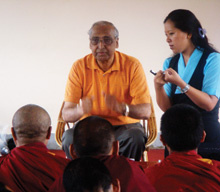People
October 13, 2010
Monks' eagerness to learn helps fulfill Dalai Lama's goal

P. V. Rao is associate professor of physics.
Four years ago, when Emory entered into a partnership with the Library of Tibetan Works and Archives in India to develop and implement a comprehensive science education curriculum for Tibetan monks and nuns, I was one of the first few faculty members who volunteered to join the Emory-Tibet Science Initiative.
The project is inspired by His Holiness the XIV Dalai Lama’s conviction that “a dialogue and cross-fertilization between science and spirituality is essential for enriching the human life and alleviating suffering.”
As a preliminary to participate in this program, I went to Himachal Pradesh in India in the summer of 2007 to teach elementary particle physics to a group of monks gathered by the Sager family foundation. That experience has given me the confidence that I can contribute to the development of this program.
When in January of 2008, His Holiness officially inaugurated the Emory-Tibet Science Partnership in a large gathering of Tibetan monks in South India, I was there to deliver the first lecture on cosmology.
Dr. John Malko and Dr. Jed Brody, my colleagues in the physics department, and Dr. David Finkelstein from Georgia Tech joined me in developing the physics and cosmology part of the curriculum.
We now believe that a five-year instruction on this and other subjects would be essential to build the necessary foundation for the monks so that they can have a general view of the scientific knowledge. More recently Drs. Tad Day, Rick Williamon and Paul Wallace joined to help us in the teaching.
We are now busy writing the reading material suitable to serve as a text for the monks. These are translated into Tibetan language. When I went to India the first year to teach, there was a Tibetan translator to translate whatever I said in English. Only a few monks in the class knew some English.
Translation is an important key in the project. I wish the monks would receive sufficient education in English language early on in their monastic studies — then the window of opportunity to learn modern science will be wider.
The monks are very alert and eager to learn the new subjects. Their eagerness to ask many questions during the class and outside is a testimony for their commitment to learn and follow the recommendation of the Dalai Lama. In their monastic studies, debate is an important activity that helps them study their subjects critically and with understanding. I wish some of our own undergraduates at Emory followed that route in their classrooms!
Our stay in Himachal Pradesh, India, was a very pleasant experience. We, the faculty who went there, received red carpet hospitality. While enjoying the relaxed atmosphere I felt I was participating in a historic process that is beginning to take shape in the lives of Tibetan monks who are living in India.
Sometimes I wonder whether I was a Buddhist in my previous life, and if I am fulfilling the karma I had accumulated then in this present encounter with Buddhist monks.
